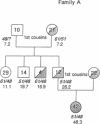Abstract
In a large kindred of 66 individuals, 22 were identified as heterozygous and 3 as homozygous for a mutation (pro664----leu) in the LDL-receptor gene that gives rise to familial hypercholesterolaemia (FH). All the heterozygotes had a raised level of plasma total cholesterol and low density lipoprotein cholesterol, but were remarkably free from premature coronary disease. Determination of apolipoprotein(a) (apo(a)) phenotype and lipoprotein(a) (Lp(a)) concentration in plasma revealed that in many instances, involving individuals with various apo(a) phenotypes, there was no difference in plasma Lp(a) concentration between an FH heterozygote and an unaffected sibling with the same apo(a) phenotype. No significant difference in Lp(a) concentration was observed between groups of FH and non-FH of the same apo(a) phenotype, although in each case the mean value for the FH group was greater than that for the non-FH group. There was also evidence for an inherited trait that markedly increased Lp(a) concentration, which did not segregate with apo(a) phenotype or the defective LDL-receptor allele. The data provide no evidence for a strong multiplicative interaction between the gene loci for apo(a) and the LDL receptor.
Full text
PDF



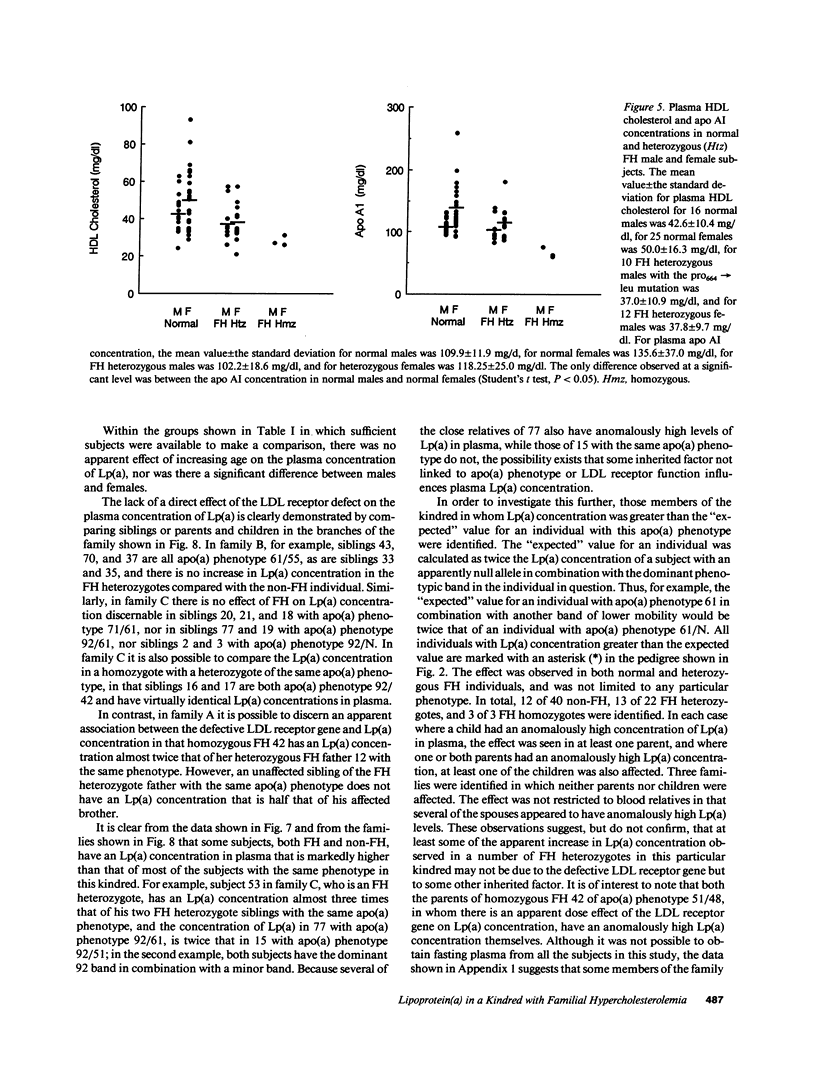
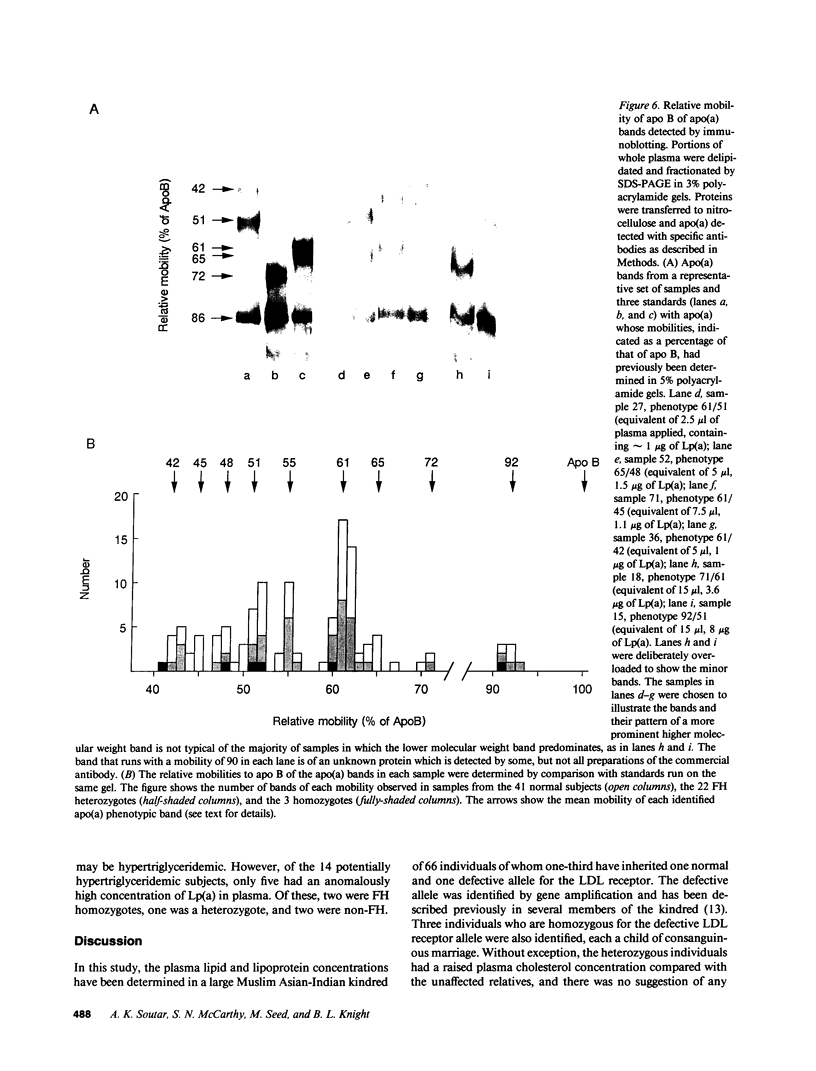
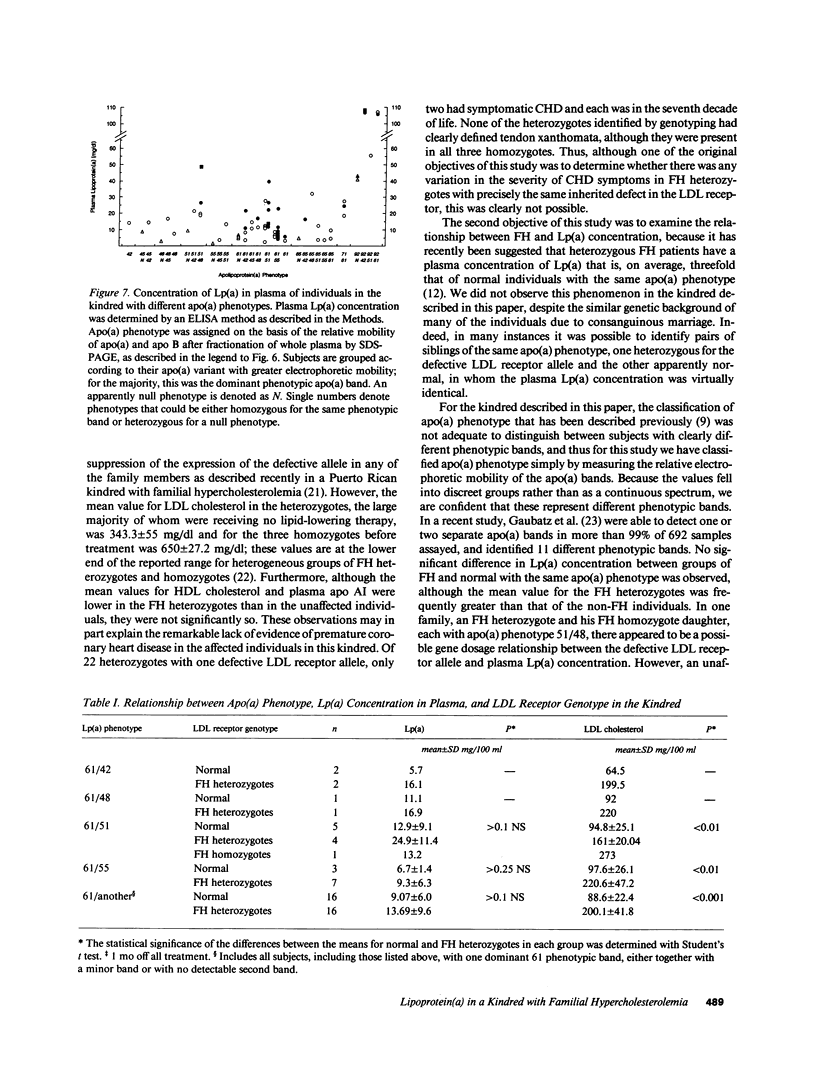
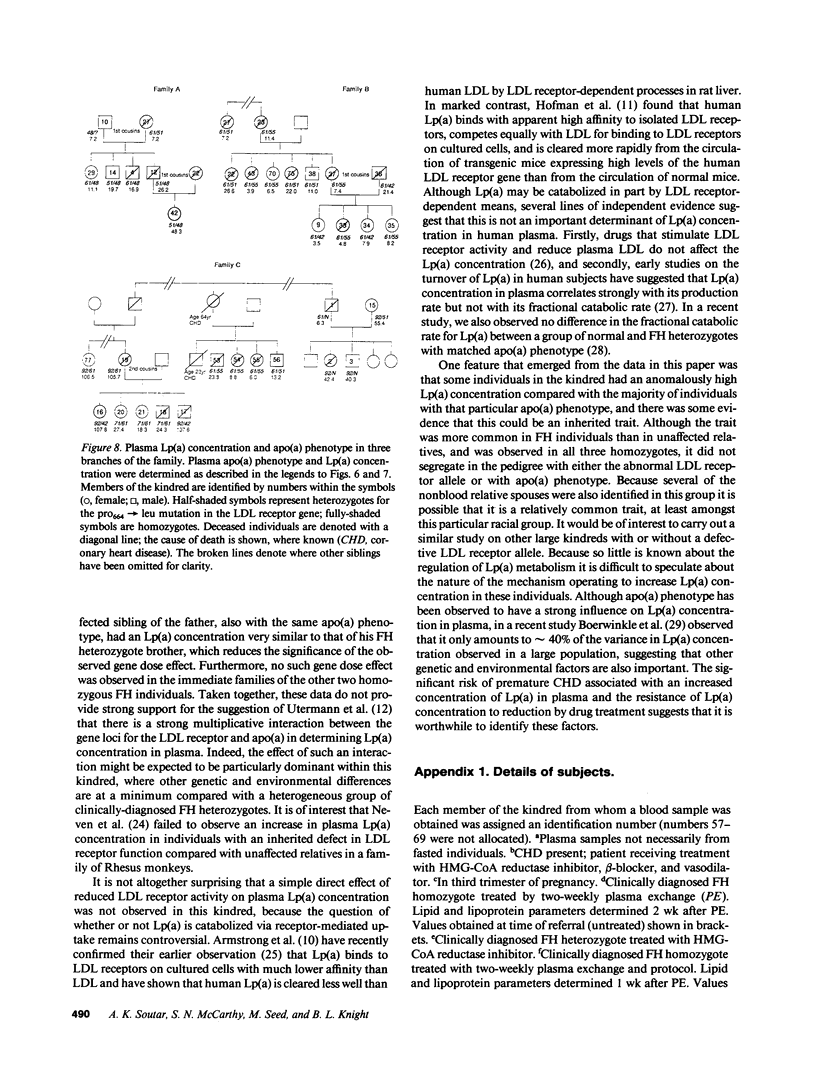
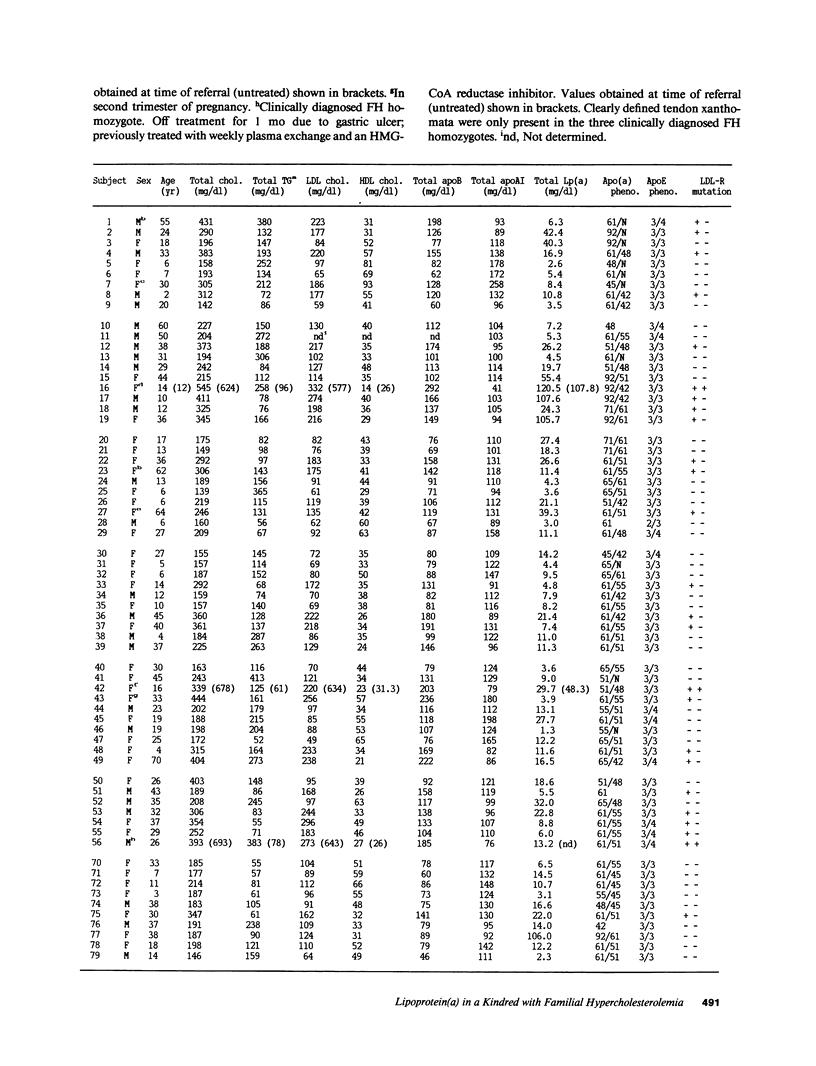
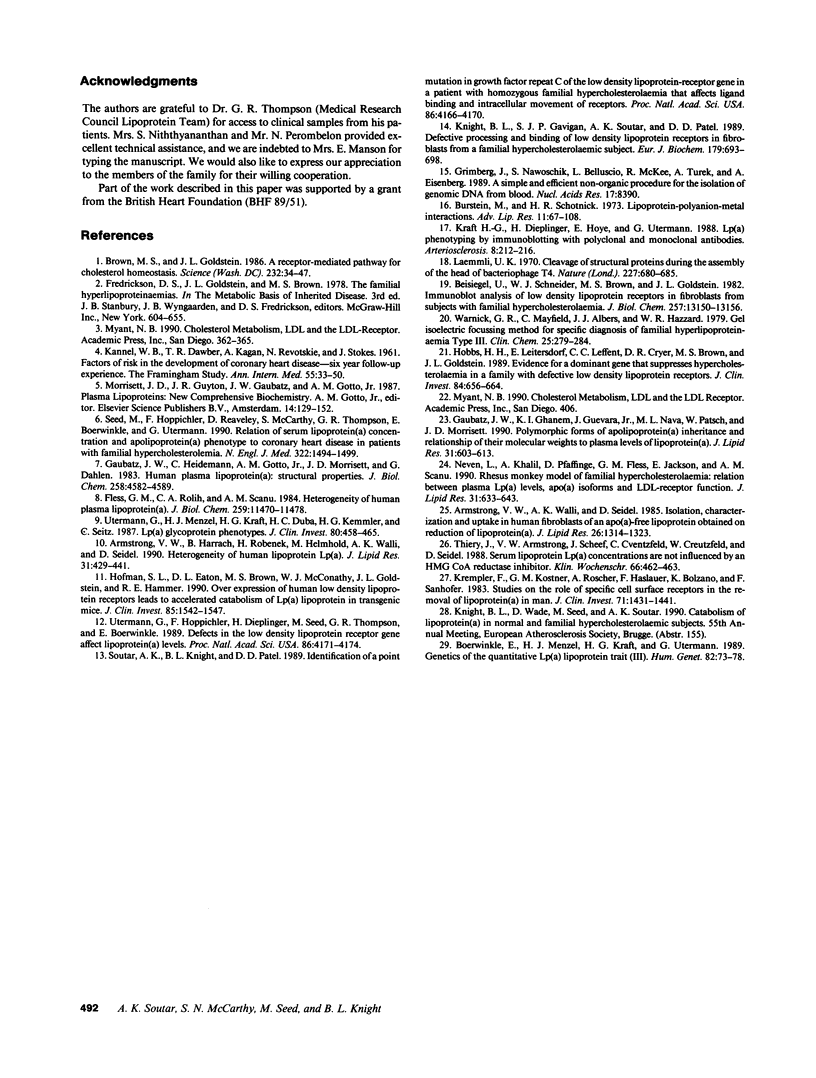
Images in this article
Selected References
These references are in PubMed. This may not be the complete list of references from this article.
- Armstrong V. W., Harrach B., Robenek H., Helmhold M., Walli A. K., Seidel D. Heterogeneity of human lipoprotein Lp[a]: cytochemical and biochemical studies on the interaction of two Lp[a] species with the LDL receptor. J Lipid Res. 1990 Mar;31(3):429–441. [PubMed] [Google Scholar]
- Armstrong V. W., Walli A. K., Seidel D. Isolation, characterization, and uptake in human fibroblasts of an apo(a)-free lipoprotein obtained on reduction of lipoprotein(a). J Lipid Res. 1985 Nov;26(11):1314–1323. [PubMed] [Google Scholar]
- Beisiegel U., Schneider W. J., Brown M. S., Goldstein J. L. Immunoblot analysis of low density lipoprotein receptors in fibroblasts from subjects with familial hypercholesterolemia. J Biol Chem. 1982 Nov 10;257(21):13150–13156. [PubMed] [Google Scholar]
- Boerwinkle E., Menzel H. J., Kraft H. G., Utermann G. Genetics of the quantitative Lp(a) lipoprotein trait. III. Contribution of Lp(a) glycoprotein phenotypes to normal lipid variation. Hum Genet. 1989 Apr;82(1):73–78. doi: 10.1007/BF00288277. [DOI] [PubMed] [Google Scholar]
- Brown M. S., Goldstein J. L. A receptor-mediated pathway for cholesterol homeostasis. Science. 1986 Apr 4;232(4746):34–47. doi: 10.1126/science.3513311. [DOI] [PubMed] [Google Scholar]
- Burstein M., Scholnick H. R. Lipoprotein-polyanion-metal interactions. Adv Lipid Res. 1973;11(0):67–108. [PubMed] [Google Scholar]
- Fless G. M., Rolih C. A., Scanu A. M. Heterogeneity of human plasma lipoprotein (a). Isolation and characterization of the lipoprotein subspecies and their apoproteins. J Biol Chem. 1984 Sep 25;259(18):11470–11478. [PubMed] [Google Scholar]
- Gaubatz J. W., Ghanem K. I., Guevara J., Jr, Nava M. L., Patsch W., Morrisett J. D. Polymorphic forms of human apolipoprotein[a]: inheritance and relationship of their molecular weights to plasma levels of lipoprotein[a]. J Lipid Res. 1990 Apr;31(4):603–613. [PubMed] [Google Scholar]
- Gaubatz J. W., Heideman C., Gotto A. M., Jr, Morrisett J. D., Dahlen G. H. Human plasma lipoprotein [a]. Structural properties. J Biol Chem. 1983 Apr 10;258(7):4582–4589. [PubMed] [Google Scholar]
- Grimberg J., Nawoschik S., Belluscio L., McKee R., Turck A., Eisenberg A. A simple and efficient non-organic procedure for the isolation of genomic DNA from blood. Nucleic Acids Res. 1989 Oct 25;17(20):8390–8390. doi: 10.1093/nar/17.20.8390. [DOI] [PMC free article] [PubMed] [Google Scholar]
- Hobbs H. H., Leitersdorf E., Leffert C. C., Cryer D. R., Brown M. S., Goldstein J. L. Evidence for a dominant gene that suppresses hypercholesterolemia in a family with defective low density lipoprotein receptors. J Clin Invest. 1989 Aug;84(2):656–664. doi: 10.1172/JCI114212. [DOI] [PMC free article] [PubMed] [Google Scholar]
- Hofmann S. L., Eaton D. L., Brown M. S., McConathy W. J., Goldstein J. L., Hammer R. E. Overexpression of human low density lipoprotein receptors leads to accelerated catabolism of Lp(a) lipoprotein in transgenic mice. J Clin Invest. 1990 May;85(5):1542–1547. doi: 10.1172/JCI114602. [DOI] [PMC free article] [PubMed] [Google Scholar]
- KANNEL W. B., DAWBER T. R., KAGAN A., REVOTSKIE N., STOKES J., 3rd Factors of risk in the development of coronary heart disease--six year follow-up experience. The Framingham Study. Ann Intern Med. 1961 Jul;55:33–50. doi: 10.7326/0003-4819-55-1-33. [DOI] [PubMed] [Google Scholar]
- Knight B. L., Gavigan S. J., Soutar A. K., Patel D. D. Defective processing and binding of low-density lipoprotein receptors in fibroblasts from a familial hypercholesterolaemic subject. Eur J Biochem. 1989 Feb 15;179(3):693–698. doi: 10.1111/j.1432-1033.1989.tb14602.x. [DOI] [PubMed] [Google Scholar]
- Kraft H. G., Dieplinger H., Hoye E., Utermann G. Lp(a) phenotyping by immunoblotting with polyclonal and monoclonal antibodies. Arteriosclerosis. 1988 May-Jun;8(3):212–216. doi: 10.1161/01.atv.8.3.212. [DOI] [PubMed] [Google Scholar]
- Krempler F., Kostner G. M., Roscher A., Haslauer F., Bolzano K., Sandhofer F. Studies on the role of specific cell surface receptors in the removal of lipoprotein (a) in man. J Clin Invest. 1983 May;71(5):1431–1441. doi: 10.1172/JCI110896. [DOI] [PMC free article] [PubMed] [Google Scholar]
- Laemmli U. K. Cleavage of structural proteins during the assembly of the head of bacteriophage T4. Nature. 1970 Aug 15;227(5259):680–685. doi: 10.1038/227680a0. [DOI] [PubMed] [Google Scholar]
- Neven L., Khalil A., Pfaffinger D., Fless G. M., Jackson E., Scanu A. M. Rhesus monkey model of familial hypercholesterolemia: relation between plasma Lp[a] levels, apo[a] isoforms, and LDL-receptor function. J Lipid Res. 1990 Apr;31(4):633–643. [PubMed] [Google Scholar]
- Seed M., Hoppichler F., Reaveley D., McCarthy S., Thompson G. R., Boerwinkle E., Utermann G. Relation of serum lipoprotein(a) concentration and apolipoprotein(a) phenotype to coronary heart disease in patients with familial hypercholesterolemia. N Engl J Med. 1990 May 24;322(21):1494–1499. doi: 10.1056/NEJM199005243222104. [DOI] [PubMed] [Google Scholar]
- Soutar A. K., Knight B. L., Patel D. D. Identification of a point mutation in growth factor repeat C of the low density lipoprotein-receptor gene in a patient with homozygous familial hypercholesterolemia that affects ligand binding and intracellular movement of receptors. Proc Natl Acad Sci U S A. 1989 Jun;86(11):4166–4170. doi: 10.1073/pnas.86.11.4166. [DOI] [PMC free article] [PubMed] [Google Scholar]
- Thiery J., Armstrong V. W., Schleef J., Creutzfeldt C., Creutzfeldt W., Seidel D. Serum lipoprotein Lp(a) concentrations are not influenced by an HMG CoA reductase inhibitor. Klin Wochenschr. 1988 May 16;66(10):462–463. doi: 10.1007/BF01745519. [DOI] [PubMed] [Google Scholar]
- Utermann G., Hoppichler F., Dieplinger H., Seed M., Thompson G., Boerwinkle E. Defects in the low density lipoprotein receptor gene affect lipoprotein (a) levels: multiplicative interaction of two gene loci associated with premature atherosclerosis. Proc Natl Acad Sci U S A. 1989 Jun;86(11):4171–4174. doi: 10.1073/pnas.86.11.4171. [DOI] [PMC free article] [PubMed] [Google Scholar]
- Utermann G., Menzel H. J., Kraft H. G., Duba H. C., Kemmler H. G., Seitz C. Lp(a) glycoprotein phenotypes. Inheritance and relation to Lp(a)-lipoprotein concentrations in plasma. J Clin Invest. 1987 Aug;80(2):458–465. doi: 10.1172/JCI113093. [DOI] [PMC free article] [PubMed] [Google Scholar]
- Warnick G. R., Mayfield C., Albers J. J., Hazzard W. R. Gel isoelectric focusing method for specific diagnosis of familial hyperlipoproteinemia type 3. Clin Chem. 1979 Feb;25(2):279–284. [PubMed] [Google Scholar]






